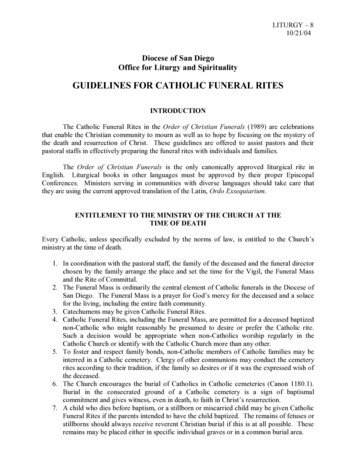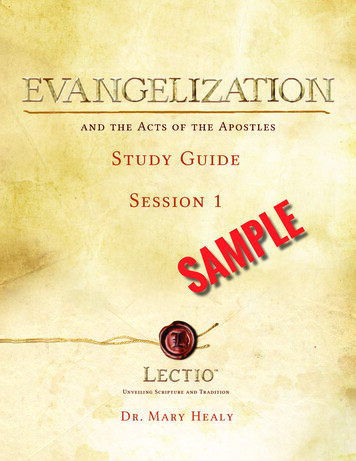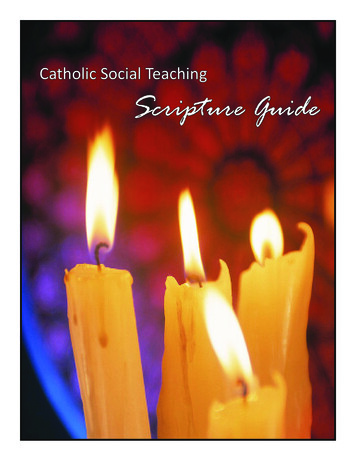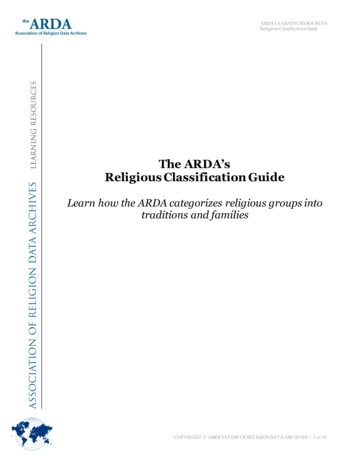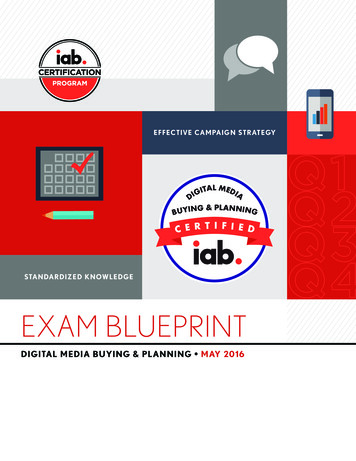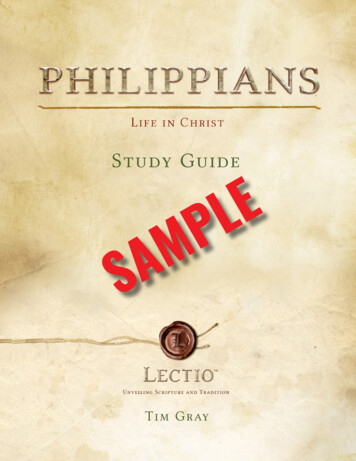
Transcription
Study GuidePMELAST im Gr ay
Nihil Obstat: Currently Under ReviewImprimatur: Most Reverend Samuel J. Aquila, S.T.L., Archbishop of DenverCopyright 2017 Augustine Institute. All rights reserved.With the exception of short excerpts used in articles and critical reviews, no part of this workmay be reproduced, transmitted, or stored in any form whatsoever, printed or electronic,without the prior permission of the publisher.Some Scripture verses contained herein are from the Catholic Edition of the RevisedStandard Version of the Bible, copyright 1965, 1966 by the Division of Christian Educatorsof the National Council of the Churches of Christ in the United States of America. Used bypermission. All rights reserved.English translation of the Catechism of the Catholic Church for the United States of America,copyright 1994, United States Catholic Conference, Inc.—Libreria Editrice Vaticana. Englishtranslation of the Catechism of the Catholic Church: Modifications from the Editio Typicacopyright 1997, United States Catholic Conference, Inc.—Libreria Editrice Vaticana.Writers: Ashley Crane, Kris Gray, Cathy LohMedia: Steve Flanigan, Justin Leddick, Kevin Mallory, Ted Mast, Jon Ervin, Matthew KrekelerPrint Production/Graphic Design: Jeff Cole, Brenda Kraft, Jane Myers, Christina Gray, Ann Diaz,Julia DeLappAugustine Institute6160 South Syracuse Way, Suite 310Greenwood Village, CO 80111www.augustineinstitute.org/programs(866) 767-3155augustineinstitute.org/lectioPrinted in the United States of AmericaISBN 978-0-9982041-5-4(Cover Art) St. Paul the apostle writing an epistle, by P. Sacchi. Restored Traditions. Used by permission.
O P E N I N G P R AY E RGlorious Saint Paul,Most zealous apostle,Martyr for the love of Christ,Give us a deep faith,A steadfast hope,A burning love for our Lord,So that we can proclaim with you,“It is no longer I who live,But Christ who lives in me.”Help us to become apostles,Serving the Church with a pure heart,Witnesses to her truth and beautyAmidst the darkness of our days.With you we praise God our Father:“To him be the glory, in the ChurchAnd in Christ,Now and forever.”Amen.—Prayer to the Apostle St. Paul,for the Jubilee Year of St. Paul (2008–2009)INTRODUCTIONSt. Paul’s Letter to the Philippians may be short, but itpacks a powerful punch. Many may already be familiarwith its popular verses such as “Rejoice in the Lord always”(Philippians 4:4) and “I can do all things in him whostrengthens me” (Philippians 4:13). But other treasures of thisepistle include the model it provides for working together inpartnership to advance the Gospel, the beautiful relationshipof mutual love that unites Paul and the church in Philippi,and Paul’s great hymn to Christ in Philippians 2:6–11. Thisfirst session begins by looking at the town of Philippi, its firstconverts, and Paul’s opening words to them in his epistle.St. Paul the apostle writing an epistle by P. Sacchi. Restored Traditions. Used by permission.3
Paul and the PhilippiansC o n n e ctHow often do you think about your citizenship? How important is it to you?Which sounds like a stronger statement: “I feel like this is important” or “I think that this isimportant”? Why?VideoWatch the video segment. Use the outline below to follow along and take notes.I. Paul’s Letter to the PhilippiansA. Short, tightly written gemB. Written toward end of Paul’s lifeC. Philippi1. Macedonian Roman colony2. Via Egnatia (Roman road)3. Philippians support Paul in prison4. Close relationship between Pauland PhilippiansD. Themes in letter1. Joy and friendship2. Citizenship—privileges and rights;key to identity3. Paul redirects Greek ideals in light of Christ4. Poem/hymn for ChristII. Greeting—Philippians 1:1–2A. Letter writer(s): Paul and TimothyB. S ervants (douloi)—slavesC. To the saints (hagioi) in Christ JesusD. With bishops (episkopoi) and deacons (diakonoi)E. Grace and Peace1. Peace (shalom)—fruit of God’s blessing;fruit of Holy Spirit2. Grace—Paul changes chairein(health and well-being) to charis (grace)4
Paul and the PhilippiansIII. Opening Prayer of Thanksgiving—Philippians 1:3–11A. Takes up Paul’s hope and concernsfor this communityB. Thanks (eucharistein)C. Joy used throughout the letterD. Partnership (koinonia)E. Greek phronein (to “think”);separation/distinction of head and heart isnot current in Paul’s day/thought D i s c u s s1. What was one thing you heard for the first time or that was an “aha” moment for you?2. What does Paul’s greeting to the Philippians tell us about his relationship with them? How doesthis greeting prepare us to better understand the rest of the letter?3. What is different about Paul’s use of common words and ideas like citizenship, peace, grace,and friendship? What does his particular use of these words accomplish in his letter?5
Paul and the Philippians“I am sure that he who began a good work in you willbring it to completion at the day of Jesus Christ.”—Philippians 1:6C L O S I N G P R AY E RLord Jesus Christ, Son of the Father,we thank you for the gift of your grace and peace.Give us the strength to be faithful to the Gospelwith which you have entrusted us.May we persevere in joy and obedience,confident that you will bring to completion your good work in us.All glory and praise to you, Lord Jesus Christ.Amen.FOR FURTHER READINGDennis Hamm, SJ, Philippians, Colossians, Philemon (Baker Academic: 2013)6
C o m m i t –D AY 1P h i l i pp iSetting sail therefore from Troas, we made a direct voyage to Samothrace, and the followingday to Neapolis, and from there to Philippi, which is the leading city of the district ofMacedonia, and a Roman colony.—Acts 16:11–12aQMap of Greece pavalena / shutterstock.comAncient amphitheater in the archeological area of Philippi, Eastern Macedonia stoyanh / shutterstock.comPhilippi was a Roman colony in eastern Macedonia (northern Greece), situated about ten milesinland from the seaport of Neapolis (modern Kavala). Philippi was founded by colonists from theisland of Thasos around 360 BC and originally named Krenides (from the Greek word for “spring”)because of the abundant sources of fresh water. A few years later the city was conquered byPhilip II of Macedon, the father of Alexander the Great. Philip fortified the city, added additionalsettlers, and renamed it after himself. Today it is still possible to view the remains of city walls builtby Philip II, a theatre likely built by Philip and renovated in the second and third centuries AD,remains of two Roman bathhouses, the agora or Roman forum, a temple dedicated to the cult of theemperor, and an aqueduct.Running through Philippi was the Via Egnatia, aroad constructed by the Roman senator GnaeusEgnatius in the mid-second century BC. It stretchedalmost 700 miles from Dyrrhachium (modern Durrës)on the Adriatic Sea in the west to Byzantium (latercalled Constantinople, now Istanbul) in the east.It ran through parts of what is now Albania, theRepublic of Macedonia, Greece, and Turkey.Roman road Egnatia, near Kavala, Greece vlas200 / shutterstock.comThe Via Egnatia, like other Roman roads, was about six meters (almost twenty feet) wide andpaved with large stone slabs or covered with packed sand. These major arteries stretched fromone end of the empire to the other and allowed the transport of trade goods, armies, officials,civilians, and postal communication. As part of this system, the Via Egnatia was essentially a7
Paul and the Philippianscontinuation of the Via Appia, the road to Rome—the Via Appia ended on the west coast of theAdriatic Sea at Brundisium, and directly across the sea the Via Egnatia began at Dyrrhachiumand continued east. Because of Philippi’s location on the Via Egnatia, the second-centuryhistorian Appian of Alexandria called it “the gate from Europe to Asia.”St. Paul travels the Via Egnatia from Philippi to Thessalonica on his second missionary journey(see Acts 17:1). Other famous travelers of the road include the armies of Julius Caesar and Pompeyduring Caesar’s civil war, Mark Antony, Octavian, Cassius, and Brutus prior to the Battle ofPhilippi, and emperor Trajan and his armies in his campaign against the Parthians in the earlysecond century AD. By the fifth century AD, the road saw decreased use, due in large part to thegrowing violence and instability in the region.In 42 BC, Philippi was the site of the decisive Roman civil war battle between Brutus andCassius (the assassins of Julius Caesar) and Mark Antony and Octavian (better known byhis later title of Caesar Augustus). Mark Antony and Octavian defeated Brutus and Cassiuson the plains west of the city. After the Battle of Philippi, the city was elevated to the rankof Roman colony, and many Roman army veterans were settled there. As a colony, Philippiwas considered a satellite city of Rome. Colonies were subject to the imperial laws of Romerather than their own local laws; they had a particular duty to behave like a loyal outpost ofRome and possessed special privileges that other cities and territories did not. The residentsof Philippi associated very closely with Rome—they were not Philippians living under Romanrule; they were Romans living in Philippi.Read Philippians 3:20. In light of Philippi’s status as a Roman colony and the large population ofRoman citizens living there, what is the significance of Paul reminding the Christians that their“commonwealth” (or citizenship) is in Heaven?We too often need to hear Paul’s reminder in our own lives. How does the world distract usfrom the truth that our commonwealth and citizenship is first and foremost in Heaven?Writing to the Colossians, Paul exhorts, “Set your minds on things that are above, not on things thatare on earth” (Colossians 3:2). At various moments during the liturgical year, the Church echoes thisexhortation in her prayers, reminding us that, as we walk amid passing things, our participationin the sacramental mysteries, especially the Eucharist, teaches us to love the things of Heaven andhold fast to what endures. Participating often in the sacraments is one way to keep our focus on ourheavenly citizenship.8
C o m m i t –D AY 2Pauland theP h i l i pp i a n sPaul first visits Philippi in AD 49 or 50 during his second missionary journey. Philippi is not Paul’sfirst choice of destination—from Phrygia and Galatia he originally tries to enter the province of Asia,but the Holy Spirit had other plans. When Paul arrives at the Aegean port of Troas, he has a dream inwhich he sees a man pleading with him to come to Macedonia (see Acts 16:6–10).Paul and his companions (Silas—Acts 15:40; Timothy—Acts 16:3; and Luke—Acts 16:10) sail toNeapolis and travel from there to Philippi along the Via Egnatia. Paul’s strategy in each new cityis to start in the synagogue and preach the Gospel to theJewish community (see Acts 17:1–2, 18:1–4, for example).However, since there is not a large Jewish community inPhilippi, there is no synagogue. As a result, Paul goes tothe river outside the city on the Sabbath (see Acts 16:13).Running water was considered clean, and so in the absenceof a synagogue Jews would gather by a river or stream as aplace for prayer and worship.At the river, Paul finds a group of women, including Lydia,a righteous Gentile. When Lydia hears the message ofthe Gospel, she immediately asks to be baptized, and shewelcomes Paul and his companions into her home. She isPaul’s first European convert to Christianity, and her housebecomes the home of the church in Philippi.St. Lydia, the first documented convert to Christianity,and it was by St. Paul Restored Traditions. Used bypermission.God-fearerActs 16:14 describes Lydia as “a worshiper of God” or a God-fearer. This title wasused for Gentiles who embraced Judaism and followed many of its moral laws. Theybelieved in the one true God and prayed and worshipped with the Jewish community,but they were not full converts to Judaism because they did not receive circumcision.Another prominent God-fearer in the early Church was the centurion Cornelius, “adevout man who feared God with all his household, gave alms liberally to the people,and prayed constantly to God” (Acts 10:2). The Holy Spirit sent Peter to preach theGospel to Cornelius and his household, and these God-fearers were the first Gentileconverts to Christianity.Unfortunately, not everyone in Philippi responds well to Paul’s work there. Read Acts 16:16–34.How do Paul and Silas end up in trouble in Philippi? How are they rescued?9
Paul and the PhillipiansNow compare the arrest of Paul and Silas in Acts 16:20–24 with their release in 16:35–39. Why doyou think Paul says nothing about their citizenship when they are accused, but brings it up whenthey are released?In hindsight, it seems that Paul and Silas could have avoided a great deal of suffering if they hadonly claimed the protection of their Roman citizenship when they were first accused before themagistrates. They didn’t use their citizenship to avoid their own suffering, but Paul demanded apublic apology so that there would be no scandal surrounding him to cast a shadow over the newchurch in Philippi.After their release, Paul and Silas leave Philippi and continue on to Thessalonica, apparentlyleaving Luke behind with the new Philippian converts (compare the “we” in Acts 16:10–17 withthe “they” in Acts 16:40 and 17:1). Paul visits Philippi again during his third missionary journey,where Luke rejoins him in his travels (see Acts 20:3–6).In his letter Paul calls the Philippianshis “joy and crown” (Philippians 4:1).The converts who so readily welcomedthe message of the Gospel wouldcontinue to “shine as lights in the world”(Philippians 2:15).Greece, archeological area of ancient Philippi fritz16 / shutterstock.comTroas and the New Empire of RomeThe Roman poet Virgil’s masterpiece the Aeneid tells the epic legend of Aeneas, whofled the ruined city of Troy and traveled west to establish his family in Italy, becomingthe ancestor of Romulus and Remus—the founders of the city of Rome. Written early inthe reign of Caesar Augustus, the Aeneid provided a masterful narrative supporting thelegitimacy of Augustus’s rule and his vision of renewing the greatness of Rome.Acts 16:11 states that Paul and his companions sailed from Troas, a seaport only milesfrom ancient Troy, to travel west bearing the Good News of the Kingdom of God.Eventually both Peter and Paul travel to, and are martyred in, Rome and, as a result,come to be seen as the twin founders of a new Christian Rome. When writing The Acts ofthe Apostles, St. Luke, an educated Greek physician familiar with Greco-Roman historyand literature, includes the seemingly trivial detail about Paul’s point of departure forhis journey to the Roman colony of Philippi and in doing so begins the reworking of thedefining narrative about Roman identity so as to point to the universal sovereignty ofthe Gospel.10
C o m m i t –D AY 3L e ct i o : P h i l i pp i a n s 1:1–2Nearly all ancient Greco-Roman letters followed a standard structure. The opening of a letteroften consisted of a simple identification and greeting: “Writer, to recipient, greetings.” Thiswould be followed by a brief wish or prayer for the well-being of the recipient. Paul follows thisbasic structure in his letters, but he makes it uniquely his own—his combination of traditionalGreek and Hebrew greetings carry the added weight of the divine subject matter and eternalsignificance of his correspondence.L E C T I O : The practice of praying with Scripture, lectio divina, begins with an active andclose reading of the Scripture passage. Read the verse below and then answer the questions totake a closer look at some of the details of the passage.Paul and Timothy, servants of Christ Jesus, To all the saints in Christ Jesus who are atPhilippi, with the bishops and deacons: Grace to you and peace from God our Father andthe Lord Jesus Christ.—Philippians 1:1–2Who is writing? How are they described?To whom is the letter addressed? How are they described?What does the author wish for the recipients of the letter?M E D I T AT I O : Lectio, a close reading and rereading of Scripture, is followed bymeditatio, a time to reflect on the Scripture passage, and to ponder the reason for particularevents, descriptions, details, phrases, and even echoes from other Scripture passages that werenoticed during lectio. Take some time now to mediate on the above verse.11
Paul and the PhillipiansFrom the Second Vatican Council document, Lumen Gentium, speaking about the universal callto holiness:The Lord Jesus, the divine Teacher and Model of all perfection, preached holiness of life toeach and everyone of His disciples of every condition. He Himself stands as the author andconsumator of this holiness of life: ‘Be you therefore perfect, even as your heavenly Fatheris perfect.’ Indeed He sent the Holy Spirit upon all men that He might move them inwardlyto love God with their whole heart and their whole soul, with all their mind and all theirstrength and that they might love each other as Christ loves them. The followers of Christ arecalled by God, not because of their works, but according to His own purpose and grace. Theyare justified in the Lord Jesus, because in the baptism of faith they truly become sons of Godand sharers in the divine nature. In this way they are really made holy. Then too, by God’sgift, they must hold on to and complete in their lives this holiness they have received. Theyare warned by the Apostle to live “as becomes saints” and to put on “as God’s chosen ones,holy and beloved a heart of mercy, kindness, humility, meekness, patience,” and to possessthe fruit of the Spirit in holiness. Since truly we all offend in many things we all need God’smercies continually and we all must daily pray: “Forgive us our debts.”Thus it is evident to everyone, that all the faithful of Christ of whatever rank or status, arecalled to the fullness of the Christian life and to the perfection of charity; by this holiness assuch a more human manner of living is promoted in this earthly society. In order that thefaithful may reach this perfection, they must use their strength accordingly as they havereceived it, as a gift from Christ. They must follow in His footsteps and conform themselvesto His image seeking the will of the Father in all things. They must devote themselves withall their being to the glory of God and the service of their neighbor. In this way, the holinessof the People of God will grow into an abundant harvest of good, as is admirably shown bythe life of so many saints in Church history.—Lumen Gentium, 40What does it mean for Paul and Timothy to identify themselves as servants or slaves (duloi) ofChrist Jesus? Can we use that term to describe ourselves?How does Paul’s use of “all” when addressing the saints (hagioi) point to the universal callto holiness?12
Paul and the PhilippiansWhat does Paul’s use of “our” in “God our Father” tell us about how we can answer the callto holiness?Oratio, Contemplatio, Resolutio: Having read and meditated on today’s Scripturepassage, take some time to bring your thoughts to God (oratio) and engage God in silence(contemplatio). Then end your prayer by making a simple concrete resolution (resolutio) torespond to God’s prompting of your heart in today’s prayer.Meditative Paul at a table in his prison cell, holding a writing quill by Rembrandt Everett-Art / shutterstock.com13
C o m m i t – DAY 4MindandHeartWhat would you say is more important: how you feel about something or what you think about it?Modern western society largely takes the distinction between the mind and the heart for granted.And when the two are pitted against each other, emotions often come out as the winner in themodern view: “Follow your heart. Don’t overthink things,” is common advice. If someone simplythinks something is true, you can try to talk him or her out of it. But if that person feels verystrongly about something, that’s likely to be the end of the conversation.The eighteenth-century intellectualmovement known as the Enlightenmentwas characterized by a focus on thesupremacy of reason. This led to adistinction between the rational mind asthe seat of thought and decision and theirrational heart as the source of emotion.There can be a wide chasm betweenPhrenology. Head brain map. Infographic.(c) Polina Kudelkina / shutterstock.comthinking and feeling, and although thisseparation originally grew out of an emphasis on the mind, it has turned upside down and oftenresults in a tyranny of feelings over reason.In what ways have you witnessed the separation of mind and heart play out in your own life? Insociety? What potential consequences does this tyranny of feelings have?But for most of history, this was not the case. Many ancient cultures—including those of Egypt,Mesopotamia, Babylon, and India—considered the heart to be the seat not only of emotion but ofreason. And so for Paul, writing from his Hebrew theological background as well as the first-centuryGreco-Roman culture in which he lived, our modern separation between the head and the heart didnot exist.A bright, red heart and gray brain sit on opposite ends Mark Carrel / shutterstock.com14
Paul and the PhilippiansPhroneinThe Greek word phronein means “to have a certain mindset.” It is often translated “tothink,” but it refers to an entire attitude or outlook, not just to a single thought. This isthe verb Paul uses in Philippians 1:7 when he is talking about being thankful for thepartnership of the Philippians (verse 5) and his confidence that God will complete hisgood work in them (verse 6). The RSV translates phronein in verse 7 as “It is right for meto feel this way about you all” (emphasis added), but Paul is talking about his mindsettoward the Philippians, not his emotions about them.Paul doesn’t just feel happy about the Philippians, as some modern translations might lead us to think.In the original Greek he says that he thinks (phronein) joyfully about them (see Philippians 1:7). Whenhe goes on to say that he holds them in his heart, he is not talking about a mere feeling of love andfriendship—although the letter makes it clear that he holds great affection for the Philippians—but ratherabout the depth and intimacy of his relationship with them.Look up the following verses. What do they say about the heart?Deuteronomy 6:4–7Jeremiah 31:33Ezekiel 36:26–27Matthew 6:19–21Luke 8:15Romans 5:5Based on these verses, how would you describe the biblical understanding of the heart?Considering St. Paul’s background as a scholar of the Law and Scriptures, what do you think hemeans when he says he holds the Philippians in his heart?“Keep your heart with all vigilance; for from it flow the springs of life.”—Proverbs 4:2315
C o m m i t – DAY 5Truth and BeautySt. Paul Writing – Pier Francesco Sacchi, c. 1520, National Gallery, LondonSt. Paul the apostle writing an epistle by P. Sacchi. Restored Traditions. Used by permission.Pier Francesco Sacchi was a painter of the Genoese guild during the early sixteenth century.While only a few paintings can be attributed to him, they are all of religious subjects, suchas his Parting of St. John the Baptist from his Parents (Oratory of St. Maria at Genoa),Crucifixion with Saints (Berlin Museum), and The Four Doctors of the Church (LouvreMuseum). In St. Paul Writing, Sacchi depicts Paul writing one of his many letters recordedfor us in the New Testament.16
Paul and the PhilippiansAs a painter, Sacchi has been described as having a lively interest in accessories, landscape,costume, and details, sometimes to the point of excess. We see such details here, but each is putto good use. Paul’s small table, supported by a scrolled pedestal, is crowded with a few necessaryitems, including his ink well, prayer book, and crucifix. But these few items are finely detailed—theprayer book with its closing strap and markers, the crucifix with its base relief, and the shapely inkwell. At the heart of these items, Paul writes on a slanted easel whose sides display an ornatelycarved scene of playful cherubs. Paul holds a reed pen in one hand, ready to begin his nextsentence. In the other hand, he holds his knife, ready for trimming his reed or cutting the paperwhen his letter is complete. Leaning against the writing desk is a sword, its long handle beautifullydecorated and engraved. St. Paul is depicted with his characteristic long beard. His trimmed bluetunic is overlaid with a vibrant red cloak, its color, along with the sword, a reminder of the deathhe will suffer for his witness to Christ.If we look out the room’s rear window, we see a detailed landscape with a city sitting along ahillside. Nearby are a river and woods, with mountains in the distance. In this scene is a solitarytraveler walking along a path, knapsack over his shoulder, approaching a bridge by which he canmake his way to the town and its people. The scene reminds the viewer of the many miles thatSt. Paul traveled on his various missionary journeys throughout Asian minor, Macedonia, andGreece. Like the traveler, Paul walked countless miles in order to preach the Gospel, and then tolater return and strengthen the Christian communities that developed among those who heard hispreaching and believed in Jesus Christ.But these many details and accessories cannot keep the viewer from the central focus of thepainting: Paul’s intense gaze upon the Cross of Christ. Look up the following verses. What doesPaul have to say about the Cross of Christ?1 Corinthians 1:17–231 Corinthians 2:2Galatians 2:20Galatians 6:14Ephesians 2:13–18Benedict XVI, in one of his General Audiences during the Pauline Jubilee Year, beautifullydescribes this focus of St. Paul:In [Paul’s] encounter with Jesus the central significance of the Cross had been made clearto him: he understood that Jesus had died and rose for all and for himself [Paul]. Boththese things were important; universality: Jesus really died for all, and subjectivity: healso died for me. Thus God’s freely given and merciful love had been made manifest inthe Cross. Paul experienced this love in himself first of all (cf. Gal 2:20) and from being asinner he became a believer, from a persecutor an apostle. Day after day, in his new life, heexperienced that salvation was “grace”, that everything derived from the death of Christand not from his own merit, which moreover did not exist. The “Gospel of grace” thus17
Paul and the Philippiansbecame for him the only way of understanding the Cross, not only the criterion of hisnew existence but also his response to those who questioned him . . . For St Paul the Crosshas a fundamental primacy in the history of humanity; it represents the focal point of histheology because to say “Cross” is to say salvation as grace given to every creature.—Benedict XVI, General Audience, October 29, 2008Interestingly, Sacchi’s painting show Paul as he writes the beautiful chapter on love from his FirstEpistle to the Corinthians. Sacchi gives us the moment just after Paul writes, “Love is patient andkind; love is not jealous or boastful . . .” (1 Corinthians 13:4). The Apostle who desired to boastin nothing but the Cross of our Lord Jesus pauses, his eyes fixed on him who is the model of thelove he is describing. Paul gazes upon the crucifix, upon him who “humbled himself and becameobedient unto death, even death on a cross” (Philippians 2:8), all so that Paul (and each of us)might be reconciled to God (see Romans 5:1–10) and spend eternity in the embrace of this love.Take a moment to journal your ideas, questions, or insights about this lesson. Write downthoughts you had that may not have been mentioned in the text or the discussion questions.List any personal applications you got from the lessons. What challenged you the most in theteachings? How might you turn what you’ve learned into specific action? 18
Study Guide Tim Gray SAMPLE. Nihil Obstat: . Standard Version of the Bible, copyright 1965, 1966 by the Division of Christian Educators . translation of the Catechism of the Catholic Church: Modifications from the Editio Typica copyright 1997, United States Catholic Conference, Inc.—Libreria Editrice Vaticana.
